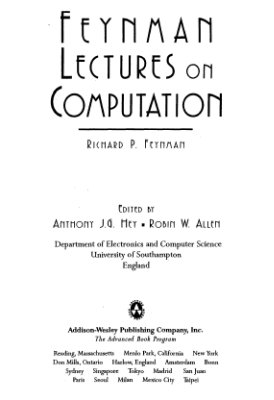Edited by A.J.G. Hey and R.W. Allen, Addison-Wesley Publishing, New
York, 1996, 318 pp. - ISBN 0-201-48991-0
Feynman had an interest in computing for many years, dating back to the Manhattan project and the modeling of the plutonium implosion bomb. In "Los Alamos from Below", published in "Surely You're Joking, Mr. Feynman!", Feynman recounts how he was put in charge of the 'IBM group' to calculate the energy release during implosion. Even in those days before the advent of the digital computer, Feynman and his team worked out ways to do bomb calculations in parallel. The official record at CalTech lists Feynman as joining with John Hopfield and Carver Mead in 1981 to give an interdisciplinary course entitled The Physics of Computation.
From Feynman's Preface
…Firstly, the lectures are not aimed solely at students in computer science, which liberates me from the shackles of exam syllabuses and allows me to cover areas of the subject for no more reason than that they are interesting. Secondly, computer science is not as old as physics; it lags by a couple of hundred years. However, this does not mean that there is significantly less on the computer scientist's plate than on the physicist's: younger it may be, but it has had a far more intense upbringing! So there is still plenty for us to cover. Computer science also differs from physics in that it is not actually a science. It does not study natural objects. Neither is it, as you might think, mathematics; although it does use mathematical reasoning pretty extensively. Rather, computer science is like engineering — it is all about getting something to do something, rather than just dealing with abstractions as in pre-Smith geology. Today in computer science we also need to "go down into the mines" — later we can generalize…
Contents
Foreword
Preface
Introduction to Computers
Computer Organization
The Theory of Computation
Coding and Information Theory
Reversible Computation and the Thermodynamics of Computing
Quantum Mechanical Computers
Physical Aspects of Computation
Afterword: Memories of Richard Feynman
Suggested Reading
Index
Feynman had an interest in computing for many years, dating back to the Manhattan project and the modeling of the plutonium implosion bomb. In "Los Alamos from Below", published in "Surely You're Joking, Mr. Feynman!", Feynman recounts how he was put in charge of the 'IBM group' to calculate the energy release during implosion. Even in those days before the advent of the digital computer, Feynman and his team worked out ways to do bomb calculations in parallel. The official record at CalTech lists Feynman as joining with John Hopfield and Carver Mead in 1981 to give an interdisciplinary course entitled The Physics of Computation.
From Feynman's Preface
…Firstly, the lectures are not aimed solely at students in computer science, which liberates me from the shackles of exam syllabuses and allows me to cover areas of the subject for no more reason than that they are interesting. Secondly, computer science is not as old as physics; it lags by a couple of hundred years. However, this does not mean that there is significantly less on the computer scientist's plate than on the physicist's: younger it may be, but it has had a far more intense upbringing! So there is still plenty for us to cover. Computer science also differs from physics in that it is not actually a science. It does not study natural objects. Neither is it, as you might think, mathematics; although it does use mathematical reasoning pretty extensively. Rather, computer science is like engineering — it is all about getting something to do something, rather than just dealing with abstractions as in pre-Smith geology. Today in computer science we also need to "go down into the mines" — later we can generalize…
Contents
Foreword
Preface
Introduction to Computers
Computer Organization
The Theory of Computation
Coding and Information Theory
Reversible Computation and the Thermodynamics of Computing
Quantum Mechanical Computers
Physical Aspects of Computation
Afterword: Memories of Richard Feynman
Suggested Reading
Index

